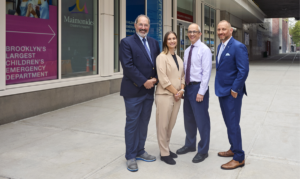Each year, more than 4,000 New York state residents are diagnosed with melanoma, and nearly 500 New Yorkers die from this type of skin cancer¹. Although it is less common than other varieties of skin cancer, like basal cell and squamous cell cancers, its higher potential to metastasize makes it the most deadly².
Maimonides’ new Melanoma Center aims to provide Brooklyn with a new resource to combat melanoma mortality through both preventive screening of high-risk patients and comprehensive, multidisciplinary treatment for patients with any stage of melanoma. Daniel Buchen, MD, brings 25 years of practice specializing in complex dermatology to his leadership of the Melanoma Center, as well as his role as Chief of Maimonides’ Division of Dermatology.
“As the Chair of Medicine and as a primary care physician, I’m thrilled to have a multidisciplinary resource for patients with melanoma or at high risk for melanoma,” said Matthew Weissman, MD, Chair of Medicine at Maimonides. “Given Dr. Buchen’s experience and Mohs training, he’s the perfect resource for patients throughout Brooklyn with complicated and serious dermatologic issues.”
What is Melanoma and Who Faces the Highest Risk?
Melanoma is a type of cancer that originates in melanocytes. Most melanomas are cutaneous, beginning on the skin, caused by DNA damage from exposure to ultraviolet (UV) radiation from the sun or tanning beds. Factors like genotype, phenotype, geographic location, and lifestyle can influence exposure to UV radiation and susceptibility to its harmful effects.
Genotypic risks include inherited mutations (genes like CDKN2A, CDK4 and BAP1), family history of melanoma, and cancer syndromes, such as melanoma-pancreatic cancer syndrome. Phenotypic risks include red or blond hair, blue or green eyes, fair skin, high mole density (more than 30 moles), and congenital nevi, or birthmarks, that are larger than the palm of the hand. Baldness also increases risk of developing melanoma from sun exposure, with scalp melanomas accounting for one third of head and neck melanomas.
“Many providers are unaware that certain diseases can be associated with heightened risk of melanoma,” says Dr. Buchen. “Patients with Parkinson’s disease, for example, have an 80% higher risk of melanoma. A weakened immune status is an additional key factor that can increase a patient’s risk. Iatrogenic suppression, like that which results from oral steroids or immunosuppressant use, and weakened immune system from diseases like HIV can increase melanoma risk. Patients with organ transplants, for example, have five times the normal risk of developing melanoma.”
Common sites for cutaneous melanoma include the back in men, the legs and arms in women, and the head and neck.
Noncutaneous Melanoma
Though the risk of cutaneous melanoma in Black, Hispanic, Asian, and other individuals of color is less than in people with fair skin, these patients are far more likely to develop more rare forms of melanoma that are not caused by UV exposure.
These include:
- Acral melanoma, which occurs on the ends of the body, including the palms, soles of the feet, or under the nails.
- Uveal melanoma, which develops in the eye.
- Mucosal melanoma, a rare but aggressive variety in mucosal tissue in the nasal cavity, sinuses, mouth, gastrointestinal tract, vagina, and anus.
“Whereas most cutaneous melanomas stem from the effects of ultraviolet radiation, we do not know the principal risk factor for these other types of melanomas,” says Dr. Buchen. “Knowing that, it is incredibly important for internists to be aware of their unique features, especially in patients of color.
“For example, one patient of mine was a Black woman with metastatic anal melanoma. This presented as minor bleeding from the anus, which she and her internist at the time attributed to hemorrhoids, significantly delaying diagnosis. In her case, this delay led to metastatic melanoma to the liver.”
Prioritizing Early Screening, Identification and Treatment
Finding melanoma can be challenging, even for dermatologists. This is especially true for early-stage melanoma as well as its less common varieties, underscoring the importance of being screened by a professional with expertise in identifying melanoma in all its forms.
“Because early diagnosis is so critical, screening patients at elevated risk for melanoma is the most important thing we can do to combat mortality from this disease,” says Dr. Buchen. “For localized melanoma, five-year survival rates are more than 98% with the appropriate treatments. Breslow thickness is the single most important prognostic factor for clinically localized primary melanoma.”
Breslow thickness refers to the vertical depth of the tumor, measured from the top of the skin to the base of the tumor using a micrometer. According to Dr. Buchen, for every millimeter (about the thickness of a credit card), the prognosis deteriorates by about 10%. Thin melanomas, less than 1 millimeters, have a survival rate of about 95%. Thick melanomas, greater than 4 millimeters, have a survival rate of about 50%. This is true even for melanomas with small surface areas.
At Maimonides’ Division of Dermatology, dermatologists offer total-body skin examinations to high-risk patients at appropriate intervals based on each patient’s assessed risk. In a screening examination, a dermatologist will examine the entire body, including the head and neck, scalp, eyelid margins, mouth, ears, back, chest, breasts, arms, fingernails, genital, buttocks, legs, feet and toenails using a dermatoscope, a handheld device that allows the dermatologist to examine deep structures in the skin. Our dermatology examination rooms have three sources of lighting: horizontal ceiling lights, vertical wall lighting and natural sunlight for the greatest visibility.
Benefits of Treatment at a Comprehensive Melanoma Center
For identified cases of melanoma, the Melanoma Center offers comprehensive treatment with the backing of the multidisciplinary expertise available at Maimonides. In both the inpatient and outpatient setting, patients benefit from the center’s collaborative, compassionate approach to care.
Surgery is the main treatment for most melanomas, and for those in the early stage, it is often the only therapy necessary. Surgical oncologists, with special expertise in melanoma, play a vital role in caring for patients who need more extensive surgeries, including sentinel node. Our multidisciplinary Division of Plastic Surgery has extensive experience in collaborating to achieve the highest quality results in oncological surgery, helping patients to achieve optimal results and return to normalcy post-cancer. Dermatopathologists carefully examine skin samples, providing the Breslow thickness and the results upon which targeted therapy and other treatments are based.
Patients may also require other oncological therapies, including radiation, which may be administered in tandem with surgical interventions to treat metastatic melanoma or to reduce recurrence risk at Maimonides Cancer Center. In the field of skin cancer treatment, immunotherapy and targeted therapies have in recent years vastly transformed care, enabling more patients to live longer lives as melanoma survivors. Maimonides’ medical oncologists are well-versed in prescribing and overseeing these latest targeted therapies for even the most complex cancer cases, as well as offering the latest clinical trials and advancing field research. Additionally, Maimonides provides extensive supportive services for patients fighting cancer, including psychological support, nutritional counseling, and palliative care, addressing the overall well-being of the patient.
“My vision for the Melanoma Center is a hub for care that brings the best of all the disciplines offered at Maimonides directly to our melanoma patients, with an emphasis on ease of access,” said Dr. Buchen. “From diagnosis to remission, we want to make this process as patient-forward as possible, whether a case is straightforward or complex.”
Primary care providers and dermatologists play a crucial role in early detection of melanoma — aside from conducting regular skin examinations, educating patients about the signs of skin cancer and their risk level for both common and rare varieties, they can significantly improve outcomes through early intervention.
Learn more about Maimonides Melanoma Center and Division of Dermatology or call (718) 283-6300 to refer a patient.




